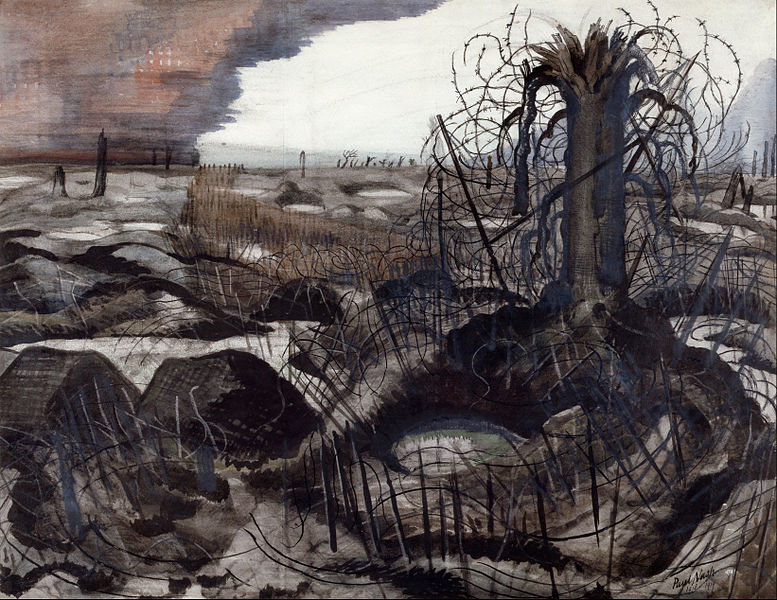Paul Nash was born in London in 1889, two years later the family moved to Buckinghamshire, his father was a lawyer, his mother died of a mental illness, his nurse and neighbours cared for him, his brother John was a painter. Paul Nash attended St.Paul’s School and then went to the Slade School of Art in London to train, his first exhibition was in 1912.
He joined the army at the start of WW1, reluctantly gaving up his art career. Later during the war he was to write:-
“I am no longer a painter interested and curious, I am a messenger who will bring back word from the men who are fighting to those who want the war to go for ever. Feeble, inarticulate, will be my message, but it will have a bitter truth, and may it burn their lousy souls.”
In France he fell into a trench breaking a rib so was sent back to England where he was commissioned to became a war painter for the Ministry of Information, enlisting in the Artists Rifles he was sent to the Western Front. Many of the sketches he did in the trenches were the basis for his war paintings. He became very unhappy working in France, hence the message he sent back to England. He was perhaps the most important painter of wars in both the first and second world wars.
In Wire he used chalk, ink and water colour on paper, he portrayed his horror of war with a scene of rain filled trenches, think of all that mud, a shattered tree and a dense web of barbed wire that we can imagine tears the skin, above we see a white sky with purple/red coloured clouds.
The painting is a symbol of the horror of war, with the barren earth and lifeless tree, the wire like a web entangles those who climb across it.
In the early 1920s he became prominent in the society of Wood Engravers and was a pioneer of modernism, he promoted avant -garde European styles of abstraction. Once WW1 ended he was free again to paint what inspired him including many landscapes. British landscapes inspired him most of all, he had a sense of their ancient history, he wished to show ‘the spirit of the place.’ Nash has been described as ‘the most evocative landscape painter of his generation.’ It can be argued that landscapes are the most popular art form, the Romantic painters liked to portray the grandeur and awe of mountain scenes, but the landscape in Wire tells a different story. Early influences were the work of painters like Samuel Palmer and William Blake, Nash saw himself working in the tradition of English mystical painters. Freud’s work on dreams also filtered into his work, he painted The Landscape from a Dream, between 1936-38, by then he was known as a surrealist painter.
In 1933 he,together with Barbara Hepworth and Henry Moore formed a group called Unit One with Herbert Read, an art critic, their aim was to revitalise English art between the war years.
Nash married in 1914, the couple lived in Dorset, he died of heart failure in 1946.


Hi Norma
Another interesting post and painting to contemplate. I just thought I’d let you know that although I don’t always comment on your visual art posts, I enjoy reading them and especially like to engage with the paintings. The bleakness of this one is very powerful.
Hi Barry,
I agree, Nash must have ‘ felt ‘ the subject of this work in his bones, having spent time in the trenches. I thought it a timely choice in order to remember that WW1 began one hundred years ago this year – the war to end all wars!